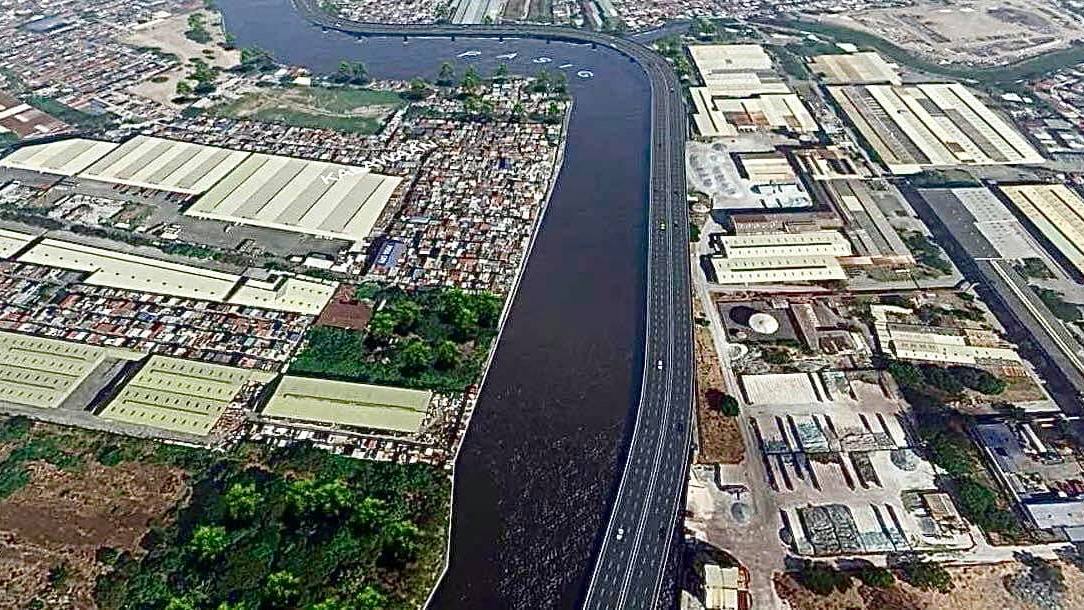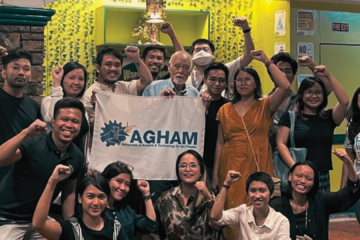By JOSE ANTONIO A. MONTALBAN

This was originally published in Bulatlat.
Ramon Ang and his conglomerate San Miguel Corporation (SMC) recently made headlines on their proposed construction of Pasig Expressway (PAREX), a 19.36-kilometer elevated highway that will pass through Pasig River, interconnecting the City of Manila and Rizal province. In spite that its environmental impact assessment (EIA) and detailed architecture and engineering design (DAED) remain unclear, Ramon Ang boasted that this expressway will incorporate applications of green architecture and engineering concepts, even claiming that it would solve the traffic congestion, as well as provide opportunities to rehabilitate Pasig River. [1]
However, various organizations have collectively taken a position against PAREX, as it would cause irreparable damage not only to the Pasig River and its interconnecting ecosystems, but also to our cultural heritage and public transportation system. We take this issue from an engineering perspective, break down each of their points, and discuss the implications of this project to both the society and the environment.
Exacerbating existing impacts: the dangers of uncontrolled dredging
Their point: Ang explained that dredging works along the Pasig River would not only provide clearing for the construction phase of the project, but also to initialize rehabilitation by reducing silt and solid waste embedded within the riverbed. [1]
Our point: What they did not point out in their submitted project description are the negative effects of dredging. [2]
Dredging will not only agitate embedded hazardous substances and pathogenic microorganisms to be released through flow stream on the riverbed, it can also worsen soil erosion in the riverbanks due to increased flow channel area and hydraulic capacity for flow discharge, thus endangering nearby communities and ecosystems thriving on the river basin. [3]
Dredged soil, with or without appropriate treatment, can be reused for the cost reduction of reclamation works. This can directly threaten marine and upland ecosystems due to contamination. This has already been the case for most areas affected by reclamation projects within Manila Bay.
More roads do not equate to clean and sustainable transportation
Their point: Ang explained that the introduction of the Pasig Expressway will help decongest traffic in NCR and nearby provinces, providing the general public with safe and sustainable means of transportation. [1]
Our point: More roads are not the answer to this country’s traffic congestion problem. It should be addressed in favor of the general public’s welfare.
More roads do not necessarily equate to clean and sustainable transportation. Without clear plans to improve the public transportation system, more roads will only increase car frequency and slow down overall traffic, thereby creating the Braess Paradox, or the phenomenon of adding a new road which results in the increase of travel time/cost of those in the network. [4]
PAREX, being a private, toll-regulated expressway, will only benefit people with private vehicles. This does nothing for the general public who is entirely dependent on public transportation.
Giving expressway access to pedestrians and commuters without creating clear provisions for a safe route access, as well as sufficient ground road infrastructure in coordination to all stakeholders, will only exacerbate existing public road safety concerns endangering the public.
Green buildings without total regard for the environment are not “green” at all
Their point: Ang also pointed out that PAREX will have green architecture and engineering provisions for a clean, sustainable, and environmentally-friendly means of operation. [1].
Our point: The introduction of PAREX in itself will do more harm to the people and the environment than good.
PAREX will be a pollution-inducing road system. It is expected that increased vehicle volume on the proposed expressway will also increase concentration of air, noise, vibration and light pollution, thus creating negative public health and environmental implications. [4][5][6]
Road-related particulates and hazardous substances proliferating on the expressway can be washed by storm water runoff, and its nearest receiving water body is Pasig River. This exacerbates the existing water pollution problem within the river basin. [4][5][6]
In order for PAREX to adhere to the green building code guidelines, they must have pollution abatement provisions. These generally require a high energy requirement to operate and the only way to compensate for this is to charge motorists through toll fees, giving them another financial burden, thereby defeating the concept of sustainability.
A tainted vision of environmental conservation
Their point: Urban planner and architect Felino “Jun” Palafox said that Ramon Ang is a “lone ranger” in the quest to clean up the Pasig and Tullahan Rivers, insinuating that SMC is the only contributor for Pasig River rehabilitation efforts. [7]
Our point: Not only does this statement vehemently discard the initiatives of various non-government organizations, individuals and communities on Pasig River rehabilitation, but it also creates a tainted impression that the projects of SMC are pro-environment – they are not.
SMC and its affiliates have been the subject of controversy and negative feedback from various environmental advocacy organizations due to the destructive implications of their projects in the environment, such as the proposed Bulacan Aerotropolis that seeks to construct an airport in Brgy. Taliptip in Bulacan at the expense of its thriving mangrove cover and wetland ecosystem. [8][9]
Cases of greenwashing activities have also been attributed to SMC such as their recent mangrove planting in Paombong, Bulacan. It was eventually assessed that the mangrove planting activity was done incorrectly – incorrect mangrove species planted in a wrong coastal zone using improper methods, and new propagules were planted within a mature mangrove ecosystem. [10]
Conclusion
We need better alternatives and opportunities other than placing an expressway within the Pasig River. If Ramon Ang, his affiliates, and San Miguel Corporation truly care for the environment, they should introduce concrete initiatives to address rehabilitative effort in our ecosystems, with a clear intention of protecting it for the greater good. Ramon Ang’s claim that Pasig River is “biologically dead” is totally a myopic statement and does not further justify the construction of the expressway. Pasig River can be restored and rehabilitated. True and sustainable should benefit people in all walks of life, without the degradation and destruction of our natural resources and ecosystems.
About the Author
Jose Antonio A. Montalban is a licensed sanitary engineer and a technical volunteer for Engineers Without Borders – Philippines (EWB-PH) and Pro People Engineers and Leaders (PROPEL). He is involved in various engineering consultancy and design work for public health and sanitation systems, pollution abatement and environmental management. He has a bachelor’s degree in Environmental and Sanitary Engineering and is currently finishing his graduate studies on Environment and Natural Resources Management with its focus on Upland Resources.
References
[1] Ramon Ang addresses criticisms vs. Pasig River Expressway project – September 24, 2021, URL: https://www.gmanetwork.com/news/money/companies/804515/ramon-ang-addresses-criticisms-vs-pasig-river-expressway-project/story/
[2] Pasig River Expressway Project – Environmental Impact Assessment; July 2021, URL: http://eia.emb.gov.ph/wp-content/uploads/2021/07/PDS-Pasig-River-Expressway-Project.pdf
[3] Evidence: Impacts of Dredging. August 2013, URL: https://www.wildtrout.org/assets/files/library/Evidence_-impacts_of_dredging-_August_2013.pdf
[4] The Braess Paradox – April 2020. URL: https://supernet.isenberg.umass.edu/articles/braess-encyc.pdf
[5] Review of Ecological Effects of Roads on Terrestrial and Aquatic Communities – February 2000, URL: https://conbio.onlinelibrary.wiley.com/doi/pdf/10.1046/j.1523-1739.2000.99084.x
[6] Evaluation of Ecological Impacts from Highway Development – April 1994. URL: https://www.epa.gov/sites/default/files/2014-08/documents/ecological-impacts-highway-development-pg_0.pdf
[7] Palafox: “I have not signed a contract with SMC for PAREX” – September 28, 2021, URL: https://business.inquirer.net/331518/palafox-i-have-not-signed-a-contract-with-smc-for-parex
[8] Aerotropolis heightens disaster risks for Bulacan communities – January 28, 2021. URL: https://www.rappler.com/environment/aerotropolis-airport-heightens-disaster-risks-communities-bulacan
[9] Bulacan Aerotropolis Project: Goodbye birds, hello big metal birds – July 26, 2020. URL: https://businessmirror.com.ph/2020/07/26/bulacan-aerotropolis-project-goodbye-birds-hello-big-metal-birds/
[10] Green groups seek probe into corporate giant’s mangrove planting initiatives – September 10, 2021. URL: https://philippines.licas.news/2021/09/10/green-groups-seek-probe-into-corporate-giants-mangrove-planting-initiatives/?fbclid=IwAR0cCmbBOhF3vHfZNr4MKq2rFjfNZG-hVi4Kzinhuu7DFsKPzXoPeCSKOoM

0 Comments